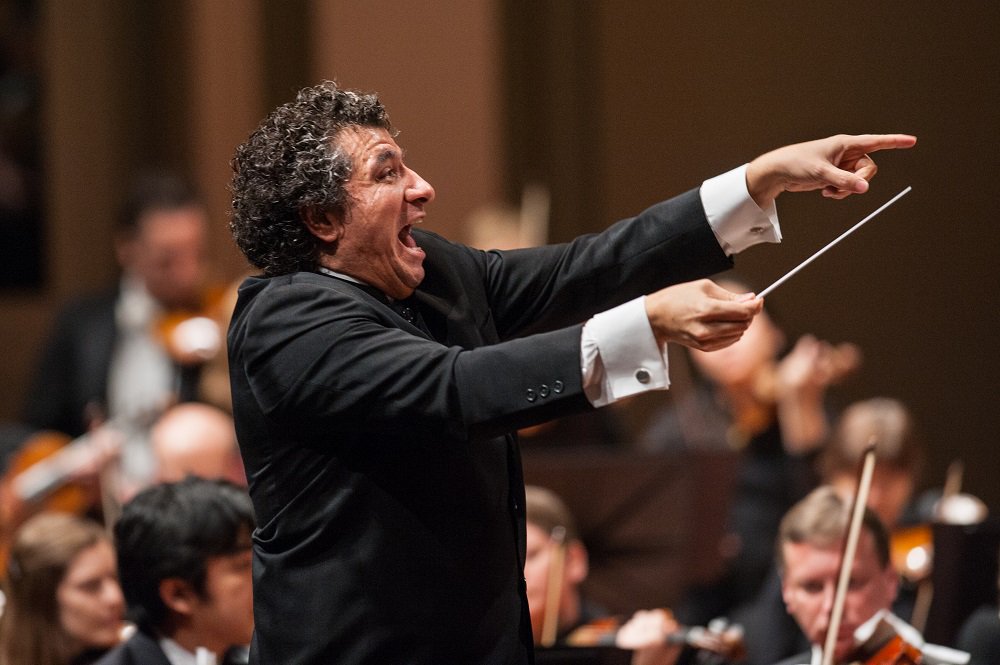Guerrero brings insight (and showmanship) to DSO’s Russian program

Giancarlo Guerrero conducted the Dallas Symphony Orchestra in an all-Russian program Saturday night.
Two reliable crowd-pleasers bookend a dark 20th-century masterpiece in this weekend’s all-Russian program by the Dallas Symphony Orchestra. All parties involved—guest conductor Giancarlo Guerrero, violin soloist Leonidas Kavakos, and the orchestra—turned in solid performances at Meyerson Symphony Center, including some surprising new insights into an overly-familiar work.
Giancarlo Guerrero, who is currently music director of the Nashville Symphony, began his professional musical career in the U.S. a few miles down the freeway as an undergraduate percussion major at Baylor University. The Costa Rican-born conductor opened the concert with Mussorgsky’s Night on Bald Mountain (orchestrated by Rimsky-Korsakov), a work familiar to a broad audience through its presence in the 1940 version of Fantasia. Guerrero immediately threw in a strong dose of showmanship, searchingly surveying the orchestra before lifting his arm for the downbeat (and, incidentally, conducting without baton or score).
He immediately proved himself to be more than just a showman, however. Beneath the visual podium emoting, there was a clean, baton-less technique, and the orchestra responded with a neat precision that it hasn’t consistently demonstrated under this season’s string of guest conductors. Guerrero also has clearly latched onto the acoustic possibilities of Meyerson Symphony Center: it’s an excellent room for orchestral music, but guest conductors have to quickly adapt to the particular characteristics involved. Guerrero did just that, exploring tone qualities and achieving an ideal balance at all times.
Greek-born violinist Leonidas Kavakos, who will be conducting and playing violin on next week’s concerts, presented a solid, low-vibrato but grippingly expressive tone in Shostakovich’s somber Violin Concerto No. 1. His opening notes emerged resolutely from the brief introductory theme in the cellos. An almost grim restraint characterized much of Kavakos’s performance, effectively framing the bursts of anger and passion that occasionally break through this often bleak musical landscape.
The cadenza that links the Passacaglia third movement to the demonic finale provided the most striking moment for this listener, as Kavakos communicated the sense of Shostakovich agonizingly exploration and expansion of the lonely arpeggio-based melody. And the violinist’s calm, straightforward delivery provided the perfect emotional frame for the technical fireworks of the finale.
Mussorgsky returned after intermission, this time in Ravel’s arrangement of his Pictures at an Exhibtion. Once again, Guerrero adopted a showy stance, with an eye to the image he projects to the audience, but still demonstrating an imaginative and effective approach to this overworked audience favorite.
He produced a neatly articulated phrasing of the Promenade theme, and consistently found surprising textures in Ravel’s orchestration. Often appropriately playful with the score, he achieved a serious impetus in the “Bydlo” section that reminded that yes, this is a piece by the master who produced Boris Godunov.
Although Guerrero’s podium showmanship and choreography became a little heavy-handed at times during Pictures, the orchestra once again responded with sharp precision, and a cheering audience clearly felt it had its money’s worth.
The program will be repeated 2:30 p.m. Sunday at Meyerson Symphony Center. mydso.com; 214-692-0203.